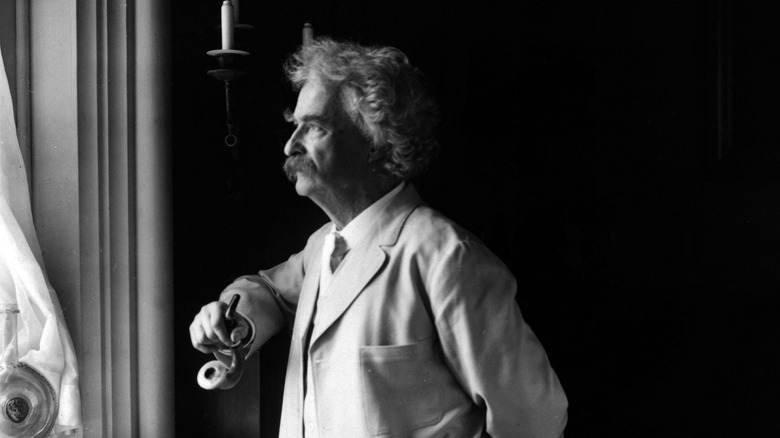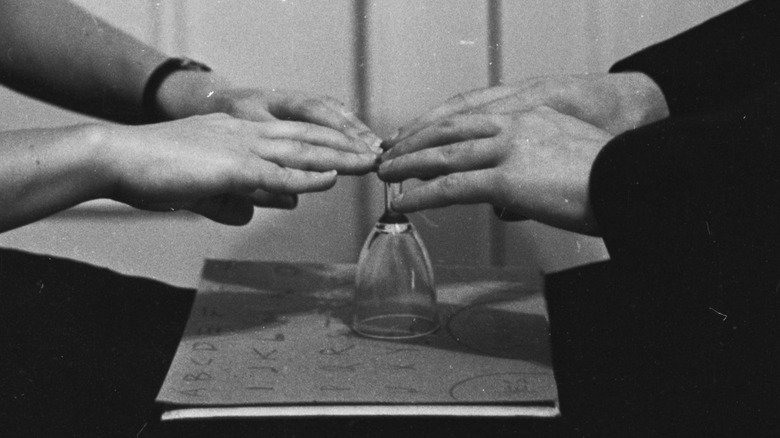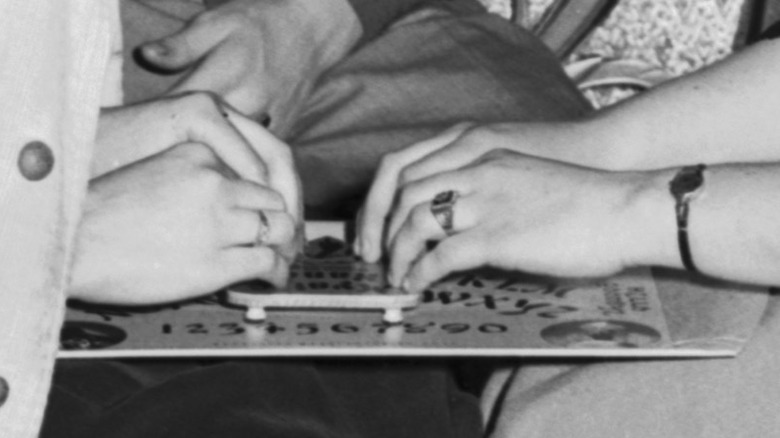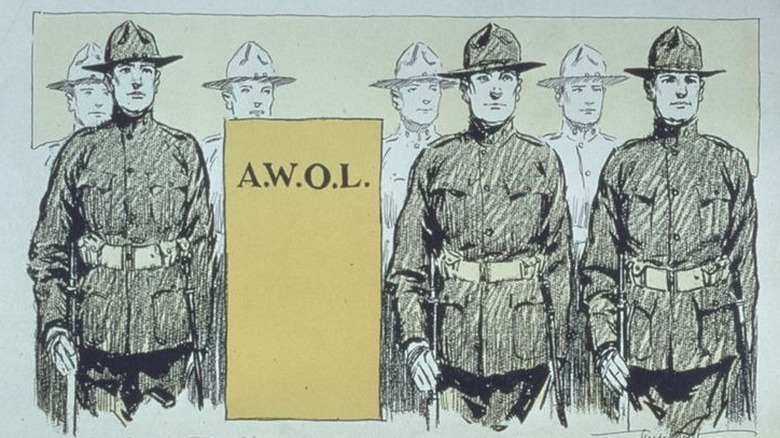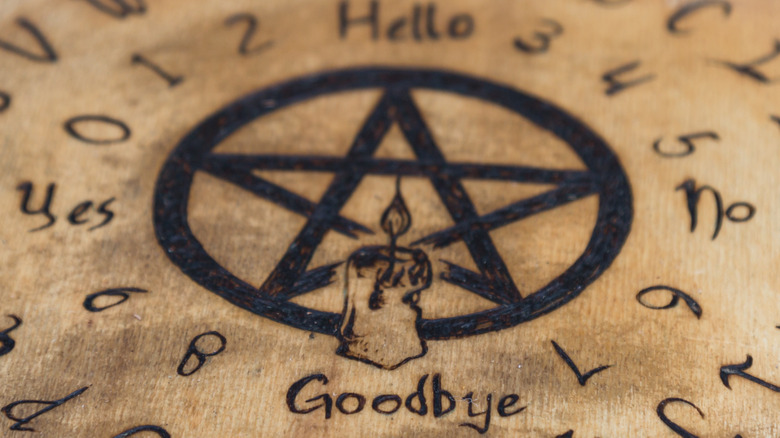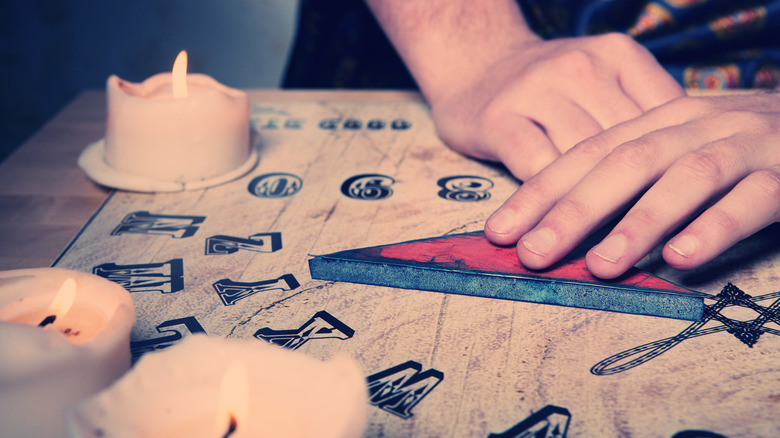Crimes People Blamed On Ouija Boards
We may receive a commission on purchases made from links.
It seems a harmless thing: a board with numbers and letters, the words "yes" and "no," and a small pointer. Hasbro sells it as a party game, directing at least two people to put their hands on the pointer and watch as it moves to spell out answers to their questions. Yet, in the years since they were first created, Ouija boards have existed in a dark context.
According to Smithsonian, Ouija boards were used in the Victorian Era and grew out of the spiritualist movement of the 19th century. In an effort to speed up purported communication with the dead, so-called "talking boards" were used by spiritualist camps in Ohio in the 1880s. A group of entrepreneurs formed the Kennard Novelty Company to manufacture the boards under the Ouija name in 1890. None of them practiced spiritualism, but cash trumped communication with the afterlife. An eerie demonstration for the patent office won their approval, and the Ouija became an instant moneymaker.
Just how it works or what it means is another story. Psychologists suspect groups of people using it fall into an unconscious movement known as the ideomotor effect. Mainstream Christian denominations (per Bill Ellis' "Raising the Devil") worry that the game is a channel for demonic influences, a perception that became more widespread among the public in the wake of "The Exorcist" in 1973. Either way, a slew of criminals over the years have pinned their guilt on becoming possessed by Ouija boards.
1917: Emily Grant Hutchings, Hannibal, Missouri
To judge by horror movies, any crimes or murders connected to a Ouija board must be of a ghastly nature. But Smithsonian suggests such a perception only took hold after "The Exorcist." In the 19th and early 20th centuries, attempting to communicate with the beyond wasn't seen as sinister or even unusual in the era of spiritualism. If the Ouija was tied to unscrupulous acts, they weren't necessarily of a violent nature.
Emily Grant Hutchings was an aspiring author in 1917 when she published her first novel. But she didn't claim to be its writer. Rather, she said that she and her friend Lola V. Hayes channeled famed humorist Mark Twain through a Ouija board, and that this was his last novel from beyond the grave. The New York Times didn't completely dismiss these claims in their review (via Twain Quotes), and while they didn't think much of the book, they did suggest it bore a resemblance to Twain's literary style.
Unfortunately for Hutchings, those among the living with ties to Twain were less indulgent. The following year (per Splinter News), Twain's publisher and his estate brought a suit against her. The plaintiffs argued that, even if Twain had written the book (which they didn't believe), his name and work belonged to the estate, with Harper & Brothers having sole publishing rights. Before the case went to trial, Hutchings agreed to withdraw the novel from publication, though she never retracted her channeling claims.
1930: Nancy Bowen, Buffalo, New York
When Frenchwoman Clothilde Marchand answered the door of her Buffalo, New York home on March 7, 1930, she probably didn't expect any danger. But she was greeted by a blow to the head from a hammer wielded by Nancy Bowen, a Seneca healer from the Cattaraugus Reservation. According to Elizabeth Reis' "Spellbound: Women and Witchcraft in America," Bowen had tried to kill Marchand with spells but, when they failed, had to resort to violence and chloroform. Her reasoning behind the? Marchand, she alleged, was a witch responsible for killing Bowen's husband.
That, at least, was what a Ouija board had told her (via WGRZ). Controlling the Ouija had been Bowen's friend, fellow Seneca healer Lila Jimerson. And, after the two women were arrested for the murder, a curious fact came to light: Jimerson had carried on a long-term affair with Marchand's husband Henri.
Henri Marchand initially tried to claim that Jimerson's passion for him was unrequited, but he eventually confessed to serial adultery on the witness stand (with his wife's approval, he insisted). Jimerson claimed that Henri had told her he was tired of his wife, implicating him as the party behind the crime. The case was heavily sensationalized, often along racial lines. After a mistrial, Jimerson was acquitted and was released after pleading guilty to manslaughter.
1933: Dorothea Turley, St. Johns, Arizona
Dorothea Turley was in high spirits at age 22. Per the San Bernardino Sun, she had won a measure of fame in a 1917 beauty contest and eloped with navy sailor Ernest Turley. Not long after, they had two children. All was well ... for a time. Dorothea's time in the spotlight was brief, and she took its absence hard. Her health began to deteriorate a few years into her marriage, and for her benefit, the family relocated near St. Johns, Arizona.
There, Dorothea developed two strong interests: the occult, and a cowboy named Kent Pearce. Pearce and Dorothea began seeing a lot of each other, with daughter Mattie often along for the ride. Mattie also partook in the séances her mother conducted with a Ouija board. In 1933, the board sent the message "D-A-D-D-Y-M-U-S-T-D-I-E," and Dorothea insisted that the board must be obeyed. On November 18, Mattie became the one to complete the message, and she shot her father in the back.
As noted by the National Registry of Exonerations, this was the story Mattie told after first claiming the shooting was accidental. Although neighbors and co-workers attested to Pearce and Dorothea carrying on together, Dorothea claimed there was no order to kill Ernest and that Mattie did it because she was fed up with his rules and was now trying to blame her mother. Dorothea was initially convicted but released on appeal. Mattie was sent to reform school until she 21.
1970s: Gary Gilmore, Utah
Gary Gilmore never claimed to touch a Ouija board himself. But his mother blamed his violence, and other misfortunes in her family, on her experience with one as a child. According to her younger son Mikal (via Psychology Today), Bessie Gilmore was convinced that a demonic spirit attached itself to the family ever since she had played around with a Ouija. She held it — and herself — responsible for the death of one sister and the paralysis of another. Her mother-in-law was a reported medium, and after a late-night séance, Bessie claimed to see an inhuman figure, who first loomed over her, and then her young son Gary.
Afterward, Gary began to have nightmares about being beheaded. Bessie's conclusion was that it was the ghost she conjured as a girl and that it claimed her son's soul and drove him to become a murderer. What Gary thought of his mother's theory, Mikal didn't say. Per Britannica, he was frequently beaten by his father and often clashed with prison authorities after his multiple arrests. In 1976, he killed two people after robbing a gas station and became the first American in nearly a decade to face the death penalty. Gilmore rejected all efforts to commute his sentence, including his mother's. In the end, Gilmore chose to be executed by firing squad. His final words "Let's do it," would go on to be the murderous origin of Nike's "Just do it" slogan.
1987: Anthony Allan Hall, Daytona Beach, Florida
Some claims of influence from a Ouija board when committing criminal acts are indirect — the perpetrator's mother thinks that's what caused it, or another person controlling the Ouija manipulated someone else to do wrong. But 25-year-old Anthony Allan Hall had no middleman; he directly pled satanic possession by way of Ouija when he was brought to trial for the murder of Ngoc Van Dang in 1987.
According to the Associated Press, Hall, his friend Daniel Paul Bowen, Bowen's girlfriend Elizabeth Rebecca Towne, and her friend Bunny Dixon practiced Satanism and consulted with a Ouija board. Hall claimed that, through it, they received guidance from a 10-year-old boy named David, who told them to leave their homes in Orlando, Florida and join a carnival in Virginia. To do this, the foursome hijacked Dang's car. They planned to rob Dang, sell his car, and use the funds to reach the carnival. After driving as far as Daytona Beach with Dang in the trunk, Dixon carved an inverted cross into his chest before Hall and Bowen shot him to death.
While Hall pinned the carnival scheme on David in his testimony, he claimed that Dixon was the one who put him under the satanic influence and that Bowen threatened to kill him if he didn't help kill Dang. His arguments didn't sway the jury; they found him guilty and recommended the death penalty in 1989.
1990: Army intelligence officers, Gulf Breeze, Florida
For believers, all sorts of things can come through a Ouija board: dead writers, demonic creatures, unspecified spirits — maybe even Jesus Christ himself, or a message about him. That's what Vance Davis and five other army intelligence officers thought they were channeling in 1990. Davis told the Associated Press that he and his friends decided to dabble in paranormal experiences at their West German base, but that they had no luck until they tried the Ouija board. Through it, they received messages that they claimed predicted the Gulf War. In late May, the Ouija told Davis and pals to get out of the army and get themselves ready, for Jesus was soon to return and the Rapture was nigh.
Davis said that the spirits speaking through the Ouija wanted him and his friends to become teachers to help lead others through tumultuous times due within five years of the message. With no legal way to get out of active duty, the officers asked the Ouija what to do. "Leave," it told them, "just leave." Despite clean service records, the men went AWOL, making their way toward a psychic friend in Gulf Breeze, Florida.
When caught, the officers were investigated for espionage, but ultimately demoted and given honorable discharges. The six went their separate ways, but as of 1992, Davis said they were still working to prepare mankind for the coming breakdown of order. The five-year timeframe has proven a bit longer than predicted.
1995: David McCallum, London, England
There are real-life stories so strange that, if they were put in a movie, many would find them unbelievable. Such was the fate of Michael Earridge, though no one would wish to find themselves in the horror story he became trapped in. According to the Scottish Daily Record & Sunday (via the Free Library), 15-year-old Earridge and his friend Stephan Curran were lured to the apartment of Earridge's neighbor, 19-year-old David McCallum, on December 2, 1995. They found McCallum's bedroom was a homemade satanic shrine, accentuated with books on Charles Manson — McCallum's idol. Earridge was stabbed 11 times, and Curran was made to put his fingerprints on the knife by McCallum and his "apprentice" and warned never to tell anyone what he'd seen.
Curran immediately informed Earridge's family, and McCallum put up no resistance when the police came. He seemed to revel in his crime, smiling throughout the arrest and his trial. He said that Satan had told him to kill through a Ouija board he had forced the boys to help him use and that he'd previously sacrificed frogs to similar injunctions. A schizophrenic, McCallum pleaded guilty to manslaughter due to diminished responsibility. He'd downed two bottles of Thunderbird wine before killing Earridge. The court accepted the plea. As for his "apprentice," Pierre Antoine, his case was taken as far as the Court of Appeal (via the House of Lords). At issue was Antoine's own diminished responsibility. The lords dismissed his appeal.
2001: Carol Sue Elvaker, Minco, Oklahoma
In February 2001, Carol Sue Elvaker killed her son-in-law in Minco, Oklahoma (via Tulsa's News on 6). Elvaker stabbed Brian Roach, 34, to death in his sleep. When her daughter Tammy took and hid the knife from her and convinced her mother to leave the house, Elvaker drove herself, Tammy, and Tammy's two children into a road sign on Interstate 44 in an attempt to kill them all. When they all survived with minor injuries, Elvaker tried to push her 15-year-old granddaughter into traffic, then fled the scene on two broken ankles. Police found her hiding naked in the woods.
Elvaker's family said she had no history of violence or mental illness before the murder. But authorities investigating found that she had become consumed with a Ouija board, and had subsequently pulled in her daughter and granddaughters. They were all playing with the Ouija the night before the murders. Elvaker became convinced that it was telling her that Roach, a former Minco mayor and councilman, was evil and needed to die. Elvaker also believed that her youngest granddaughter, 10, was evil and was suspected of trying to kill her too. Tammy was ultimately arrested as an accessory to murder, having hid the weapon, furnished a getaway vehicle, and ignored Roach's pleas for help. Had he received it before bleeding to death, he might have survived the attack.
2007: Donald Schalchlin and Joshua Tucker, West Richland, Washington
Young men in adolescence entertain many ideas for future careers. Donald Schalchlin and Joshua Tucker of West Richard, Washington had the unfortunate aspiration to become serial killers. On December 19, 2007, per KNDO 23, the boys were caught trying to leave Schalchlin's house after a 911 hang-up call brought the police to the scene. Officers found Schalchlin's mother and sister stabbed to death.
Both boys had prior criminal records and the police had been called out to the Schalchlin home, where Tucker also lived, several times in the past. According to the Tri-City Herald (via the Daily News), the house was filthy and pet-infested. Schalchlin's defense would argue that this was what triggered Tucker to pursue murder and drag Schalchlin down with him. The boys worshiped the devil and asked a Ouija board if they would become serial killers. When they asked who their first victims would be, the Ouija answered: "M-O-M."
In trial, both boys accused the other of controlling the Ouija board, but Tucker was undeniably the killer. Schalchlin's defense claimed he was under threat himself and aided Tucker out of survival instinct, but the prosecution argued that Schalchlin was a willing accomplice whose only thought after the murders was to fetch a PlayStation. When Schalchlin was given 9 ½ years for his role, his aunt furiously protested in Benton County Superior Court. She compared his sentence to Bernie Madoff's and found her nephew's ridiculous, given the nature of his crime.
2015: The Carroll family, Leadgate, England
A Ouija board wasn't blamed for one crime in Leadgate, England during the early months of 2015 — it was blamed for several, by multiple members of the same family. According to the Northern Echo, the trouble started when Paul Carroll claimed that malign spirits first channeled through a Ouija board sitting on Christmas Eve compelled him to drown the family's Bedlington terrier, which he then dismembered.
Even after a horrific incident like that, Paul's family continued to use and put stock in the Ouija. His wife, Margaret, and his stepdaughter, Katrina Livingstone, sat with it on January 30, 2015. A neighbor later claimed that Katrina had told her that they received a warning they were going to die. In what appeared to be arson to counter whatever threat they faced, the Carroll house went up in flames on the first of February. Whether or not the fire countered any supernatural threat, it posed a serious risk to the neighborhood. Residents were evacuated in case the fire spread and set off explosions from gas bottles. Margaret and Katrina were found in their garden and taken to the hospital in critical condition.

